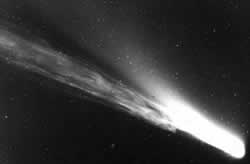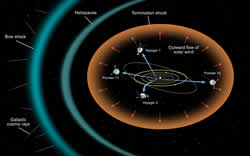
Sun-Earth Day Presents: Eclipse, In a Different Light
From comet tails to cosmic rays, the invisible solar atmosphere makes itself felt near Earth, and far beyond Pluto.
TECHNOLOGY THROUGH TIME ISSUE #47: DISCOVERY OF THE HELIOSPHERE

Comet Mrkos in 1957 showing its smooth dust tail, and its turbulent gas/ion tail. Deflections between the gas tail and the dust tail can be used to track the solar wind near the comet, much as a wind sock tracks wind direction near an airport.
Total solar eclipses and powerful magnetic storms on Earth were witnessed during the 1800's. Their explanation led to many ideas about material ejected from the solar surface and launched into interplanetary space. The real turning point for investigating the 'solar wind' came in 1943 when German astronomer Cuno Hoffmeister showed that comet tails were actually deflected by this wind. Careful studies of cometary gas and dust tails showed that the gas tail deviated by many degrees from the direction they should take if only the pressure from sunlight was involved.
In 1951, Ludwig Biermann at the University of Gottingen correctly interpreted this deflection in terms of the interaction between the cometary ions in the tail and the solar wind. The tails should always point directly away from the sun if the only thing acting on them was the pressure from sunlight. Comet tails, like million-mile-long windsocks, pointed in the direction that the solar wind was blowing near them. Biermann showed that the pressure from Sunlight was not enough, and that the force must be provided by a stream of particles traveling away from the Sun at speeds of hundreds of kilometers per second. But how could the solar wind get so far from the sun and affect the most distant comets?
By 1955, British physicist Sydney Chapmen concluded that, because the corona was so hot (million degrees), it must also exist beyond the orbit of Earth. A few years later, Eugene Parker at the University of Chicago showed, mathematically, that an expanding, supersonic, hot corona would produce a solar wind that exactly accounts for comet tail deflections.
Much of the early discussions about the heliosphere were the result of cosmic ray studies. In 1956, studies of cosmic ray energies by Philip Morrison (1915-2005) at Cornell led to the realization that Earth had to be immersed in a region of tangled interplanetary magnetic field of solar origin. Leverett Davis at CalTech, and Meyer at the University of Chicago concluded from their studies that a good fit to the data would obtain if the cavity were about 200 AU in diameter. At the outer boundary, cosmic rays from solar flares would be scattered back into the inner solar system and detected at earth. Hannes Alfven (1957) later introduced the notion of an interplanetary magnetic field carried along with the solar wind.

A rendition of the major regions of the heliosphere and locations of the Voyager and Pioneer spacecraft. (Courtesy JPL)
Despite the landmark work by a number of scientists, the concept of a solar wind was still considered controversial by many researchers in the late-1950’s. This wasn’t settled until space probes were flown that were able to record this stream of material high above the Earth's atmosphere, proving its existence.
The first hint that a solar wind existed as something that could be measured came with the work by Soviet physicist Konstantin Gringauz in 1959 during the Lunik 2 and 3 missions. Instruments measured the total electric charge of arriving ions, but he claimed that the signal strength changed as the spacecraft spun around its axis. Some kind of ion flow was entering the instrument whenever it faced the Sun. A more careful analysis of the data failed to find any evidence for the signal. In 1961 Herbert Bridge, Bruno Rossi and scientists at MIT obtained more detailed observations with the Explorer 10 spacecraft, but the data were still not convincing to many because the probe was designed to study particles in Earth's magnetotail, which confused the analysis.
Then in 1962, Mariner II (built on a rush 11-month schedule at JPL) flew towards Venus. It not only detected a continuously flowing solar wind, but also observed that it had fast and slow streams, repeating at 27 day intervals, and in step with a rotating sun. The discovery of the solar wind is almost universally credited to the Mariner 2.
More recently, the NASA spacecraft Pioneer 10, 11 and Voyager 1 ,2 have traveled beyond the orbit of Pluto. Although the Pioneer spacecraft stopped working before they reached the edge of the heliosphere, Voyager 1 is now twice as far from the sun as Pluto.
In November 2003, Voyager 1 began to detect the faint radio signals of the edge of the turbulent heliopause boundary. In December 2004, Voyager 1 passed through the 'bow shock' region where solar wind gases and magnetic fields are compressed by their impact with the interstellar medium. By 2006, the spacecraft is now traveling through the heliosheath region; its last stop before entering interstellar space. Having left all traces of our solar system behind, except for its gravity, scientists expect that Voyager 1 will become our first operating 'interstellar probe' in the next few years at a speed of 520 million kilometers per year.
Technology Through Time
ISSUES
- #46: The Magnetic Sun
- #45: Coronagraph
- #44: Einstein
- #43: Coronium
- #42: The Sun - In a Different Light
- #41: Gallery of Drawings
- #40: First Sun Photo
- #39: Solar Spectroscopy
- #38: George Ellery Hale
- #37: Coronal Mass Ejections
- #36: First Corona Descriptions
- #35: First Sunspot Drawing
- #34: Ptolemy
- #33: Ancient Greece
- #32: Ancient Babylon
- #31: Galileo Galilei
Eclipse Fact
There are at least 2 solar eclipses per year somewhere on the Earth.


